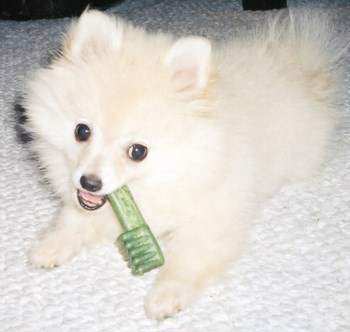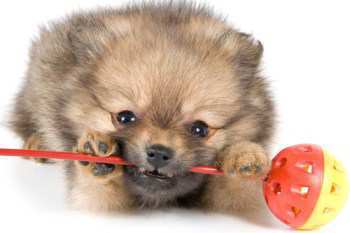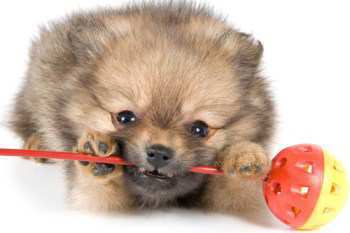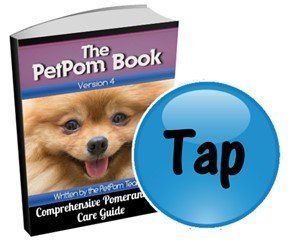Chewing & Teething
PetPom

The
Pomeranian
Information
Center
Pomeranian Chewing and Teething
Overview
Many Pom owners have tons of love for their dog but
a bit of frustration in regard to chewing issues.
While puppies are usually most infamous for destroying shoes, books, and just about anything not made out of metal, adult dogs can have chewing issues also.
Whether you have a Pomeranian puppy that is going through the teething process or an older dog that loves to chew on your shoes, table legs, or other things, these issues can be resolved.
Before We Begin
Of all the email that we receive, at the top would be owners frustrated with chewing and teething issues (who did not read this page first). Most are looking for quick, immediate help.
There are indeed methods to greatly reduce chewing problems, and to help a teething puppy. However, it must be noted that there are no magic words.
But, if you put a bit of work into setting things up correctly, and you obtain the correct aids, issues can indeed be resolved.
The methods to help with teething and to help with obsessive chewing are very similar, with just a few variations. So, first we will do an overview of each issue, and then dive into exactly what should be done to keep things under control.
Age of PomeranianPuppy Teething
Age of Pomeranian Puppy Teething
Pomeranian puppies begin to lose their puppy teeth at the 4 month mark. Some may start a few weeks earlier, and some up to one month later.
Typically, it happens in this order:
• 4 months old - the incisors begin to grow in
• 5 months old - the canine teeth begin to grow in
• 6 months old - the molars begin to grow in
• By 8 months old, a Pomeranian puppy should have all teeth ascended and stop teething. Do keep in mind, that some Poms are late bloomers and teething may last a bit longer, up to the 9 or 9.5 month mark.
What Happens During Teething
When a puppy is teething, there is moderate to severe itching and discomfort. It comes and wanes; however, each day there will be periods of time that it is quite intense.
The only thing on the mind of a teething puppy is to make the unpleasant sensations go away. The habit of seeking out toys is not very strong yet. Therefore, nothing is off limits. Just about anything that a puppy can mouth, he will. Each item may be chewed on to find out if it relieves the teething pain and itching.
In addition, a Pom pup might nibble or chew on his owner's fingers or side of her hand. While the nips can be gentle at first, this can develop into more intense type chewing that is just about the equivalent of a bite.


Mojo
Photo courtesy of owner: Lilly Fowler
Chewing Issues
Aside from chewing problems that occur during the 4 to 8 or 9 month teething phase, a dog may develop a chewing habit.
There are 3 main causes of adult chewing problems:
1. In some cases, this develops because proper methods were not in place during the teething phase. The Pomeranian never learned right from wrong. Therefore, chewing on non-toy objects has become the norm.
2.
Stress or boredom can cause a Pomeranian to display excessive chewing tendencies. This is most often seen with dogs that spend time home alone.
3.
Lack of proper chewing toys.
If a Pomeranian is not equipped with the right chew toys, and he has the basic canine urge to chew, what else is he to do but look for alternatives.
How to Help with Teething and Stop Chewing Issues - Step by Step
Please note that these steps are numbered for a good reason; if you skip any of these steps, you may not have very much success.
When all of these elements are combined, you will find that teething and chewing issues are completely resolved.
#1 Proof the House
This is not just for Pomeranian puppies; this is applicable to Poms of all ages. Go through the house, room by room, and proof it. Be sure to follow each suggestion, even if your particular Pom has not had an issue with it yet. This will be to not only stop issues now, but prevent them in the future.
- All shoes, gym bags, pocket books, remotes, books, magazine holders, small throw rugs, keys, anything that may be on the floor or within reach of your Pomeranian should be moved to new areas out of reach. Just this step alone completely resolves the issue of chewing shoes and other such objects.
- Comb the floors to pick up any dropped items including coins, hair pins, and other small things that can be inadvertently ingested.
- Wrap any electrical cords or cable wires with a cord concealer like PetCord's Dog and Cat Cord and Cable Protector
. This step completely eliminates any issues of a Pom being electrocuted from chewing on such things.
- If you have an older Pom that is even suspected of being able paw open lower cabinets, place child-proof locks on them.
#2 Have a designated area for your Pom
Teething puppies and older Poms with chewing problems should never be allowed to have free reign in the house when home alone, when an owner cannot keep a very close eye on them, or when sleeping.
The answer is to have a quality canine indoor playpen.
These are also highly recommended as an important step for helping with separation anxiety issues, and as a vital part of properly house breaking a puppy.


The pen will be your Pom's 'den' and he should be there anytime that you are not able to be right by his side. Ahead we will discuss what to do if you are
with your Pom and he is trying to chew your hand, goes to chew on a table leg, or other types of situations.
Some owners resist the playpen method, since they want their Pom to be 'free'. However, free and able to chew anything and everything in a house is not the proper place for a teething puppy or dog with a chewing habit.
And, a playpen is not a jail; it is a good sized, designated area that holds all of a Pom's important items, and keeps a dog safe. If you set the playpen up properly, your puppy or dog will be happy and comfortable there.
Within the playpen, there should be 4 main areas:
Food & water bowls, a quality bed, an area for toys, and the fourth area is for pee pads (unless you have an adult that is 100% fully trained).
When choosing a pen, options are molded plastics pen with or without a doggie door, or pop-up pens.
#3 Arm your Pom with the right tools to help with teething and chewing
If a puppy or dog does not have the right teething and chew toys, he is being set up for failure. Without a means to satisfy his chewing urges, he is being offered no other alternative than to chew on non-toy objects.
You may be thinking, 'I have tons of toys for my Pom, it's not helping.' But the idea is not to have a huge pile of them. In fact, this can be counterproductive if the good ones are hidden at the bottom and rarely discovered. The goal is to only have ones that effectively meet the needs of a pup or dog that has to chew to feel better and quell his urges.
Therefore, a huge part of this will be to ensure that you carefully select a few good teething toys and dog chews that do their job.
Recommended Teething Toys:
It can be a bit tricky to find really good teething and chew toys for Pomeranians, because many of these are designed and sized for medium and large breed dogs (who, at the puppy stage are often bigger than a full grown Pom).
However, there are a few really fantastic ones.
Nylabones are awesome. While these do not seem to be a favorite of large breed owners (big dogs with big teeth can be done with one in just a few hours), several are sized for small dogs and work very well for Pomeranians.
They are designed to help with strong teething and chewing urges. Important features include tiny bristle-like texture that works to scratch the itchiness on the gums. Many are also flavored. And this is super helpful as well, since the flavor (like chicken or beef), keeps a teething pup or chewing obsessed dog wanting more.
Rope chew toys
- A twisted braid rope is a favorite among teethers and chewers; the texture of the fabric seems to offer just what a dog wants. A great tip
is to wet the rope toy and chill it in the freezer for several hours. Then, when you give it to your Pom the toy itself and the coolness that emits from it really helps with teething pain.
Recommended Chew Toys for Older Pups and Adult Pomeranians:
As with teething toys for puppies, comes the issue that many chew toys are also sized for larger dogs. And if you do find one that is small, will it still work effectively?
Fortunately, there are a few good options. And they meet the most important requirements of a great chew toy: They are durable and are textured to please a chewing machine. And, exceedingly important to the entire method of helping with chewing issues, are designed to promote engagement and hold a dog's interest.
Chew toys that hold treats. These can work very well to satisfy a dog's urge to chew, not only do they provide a pleasing chewing experience, but
while slowly releasing treats which automatically rewards a dog to chewing on a toy.
This means that a complete step
in handling chewing problems is done for you. These are perfect for when a dog is home alone or when you are home but busy with other things. And, one of our favorites, the Busy Buddy Barnacle Treat Dispensing Toy, is available in size extra-small.
Kong low stuffed squeaker toys.
These are great because the Kong name ensures a durable, quality toy to meet chewing needs, the low-stuff filler ensures that it fits easily into a small dog's mouth, and the squeaker element offers a dog reason to keep chewing on it.
Crinkle chew toys.
These are fantastic because some of the better ones have 3 entertaining features: a crinkle material that is within the toy for awesome chewing texture and sound, a rattle, and a squeaker. These three elements combined can help to keep a dog's focus.
Speaking toys.
Toys that let out funny noises and speak sentences are always a favorite. If chewing is due to boredom, this will fit the bill perfectly.
The Babble ball comes with two options. One speaks 20 different sentences like 'Come here, puppy!', 'Hey, baby!', and 'Hot diggity dog!'. And the other type lets out 20 different animals sounds like frogs, birds, goats, tigers, and even dogs.
To summarize your tools:
You now have a great playpen for your Pom to be in any and all times
that you cannot be right by him, it holds a quality, comfortable bed, his food & water, and a nice supply of 3 or 4 quality teething toys and/or chew toys.
This immediately will resolve all issues such as a Pom ripping apart the under rim of a sofa, chewing on shoes, digging and gnawing at carpeting, turning into a woodchuck to eat away at the legs on your kitchen table, and other such behaviors.
Ahead, we will discuss how to react and what to do if your Pom is right by you, but is trying to chew non-toy items.
#4 Teach your Pomeranian to stop chewing on non-toy items
Once you are set up with the previous elements, it will be time to start implementing some rules. It is important that everyone in the household is on board, so that they will be followed at all times. This is really the only want to stop destructive chewing.
As long as you have the patience to stay with things, and can outlast your Pomeranian, new healthier chewing habits can take the place of older ones.
The basics of this are: Interrupt, Redirect Focus, Reward.
This is a fundamental training technique that works very well for many behaviors aside from chewing, such as stopping a Pom from out of control barking, jumping up, and other such things.
1. Interrupt.
Anytime that your Pom is about to chew on something that is not one of his teething or chew toys, immediately stop his action and gain his attention.
For some Pomeranians, but certainly not all, a firm 'No!' or clapping your hands loudly will be enough. Do not be discouraged if this fails, since many pups and dogs are used to hearing a 'no' to the point that it no longer has much meaning. And, clapping is not always loud enough.
A very effective technique
is to use a safe behavior corrector. And the type that we are talking about is one that emits a short hissing noise. It is not really a matter of it making a loud noise, but rather that the particular type of sound causes dogs (and other animals) to take immediate notice, and stop whatever action they were involved in.
2. Redirect Focus.
For this second part, the goal is to make a trade. To offer a preferred action over what your Pomeranian was doing before. And for this, it will be to offer a tempting teething or chew toy, using one that meets the elements that we previously discussed.
You may find that one of two things works best. You can make this be one of your Pom's favorite toys; in other words, one that you are confident that he will be happy to be reminded of.
The other option is to have this be a 'secret' toy that you have stashed away, but kept close at hand, to offer just for these circumstances.
3. Reward.
Not needed in all circumstances, because you don't want to interrupt a Pom if he's happily chewing on an approved object or very focused on playing with something. But, if your Pom looks up at you, or takes pause, it is a good idea to say, 'Good, girl!' in a happy tone and/or give a small pat.
Pomeranians are highly aware of their human's vibe, even if nothing is said. Once you've followed the first two steps, and your Pom is displaying great behavior, stress is lifted from the room. And he'll be well aware of that.
Chewing on Large, Immovable Objects
You've proofed the house, so that no small objects can be picked up and chewed, but what about the big ones? Table legs are a favorite for many dogs. And there are other larger objects such as material hanging down from sofas, and whatnot.
Let's tackle this:
#1. Do not allow access when you can't watch your Pom.
If your Pom is ripping apart carpeting or has just about chewed off the leg on your dining table, he's been allowed to do it. Follow the procedures as shown earlier of keeping him in his playpen when you cannot watch him, and this resolves the issue quite well.
While you may like to envision that it would be nice to have your dog freely roam your house, this is just not realistic in many cases. Potty accidents, rummaging through things, chewing things apart... and let's not forget that big empty houses are not the right environment for a Pom that has separation anxiety. So, using a playpen is not just good for you, it is the best thing for your Pomeranian.
When you are home, and when you are nearby, your Pom can be out and about in whatever room you are in.
#2. Use the Interrupt, Redirect Focus, and Reward training, as mentioned earlier
if your Pom goes towards something that you do not approve of.
#3. Use a quality deterrent spray.
While following our advice will nullify the issue, if for some reason you do want to let your Pomeranian have access to large items that cannot be moved, one option is to use a deterrent spray.
These are safe sprays that contain particular flavoring agents, most often a bitter taste, that deter a dog from wanting to mouth or chew on things. Some are more effective than others, and none work for all dogs. Oddly enough, some dogs do not mind the bitter taste. That said, Grannick's Bitter Apple for Dogs
 is a good choice.
is a good choice.
Chewing on You
While it can seem cute at first when a young pup softly nibbles on your fingers or the side of your hand, it is not a good idea to allow this to happen. It can very easily develop into a habit, and then you'll be in trouble when sharp teeth start to grow in.
If your Pom already has this habit, one extra step to take, is to pull back your hand as if you were offended, and let out a sharp 'Ouch!' and move away. This mimics what young pups are used to with littermate play. One nips at the other, the victim feigns injury and removes himself from play.
If this continues, use the training mentioned earlier
of sharply getting your Pom's attention, and offering an approved chew toy.
If this does not work, and your Pomeranian is getting very aggressive, though that is a topic for another time, you will want to place him in his playpen for a timeout. This mimics what serious offenders receive in the canine world, which is temporary banishment from the 'pack'.
If you email photos to us, you agree that PetPom is given free copyright to use at our discretion. We will always credit the photo to the name of the Pom's owner(s) if it is supplied.
Email: Contact@PetPom.com
All text, images and artwork protected by US and International copyright laws. All rights reserved. Copyright PetPom.com
We are a participant in the Amazon Services LLC Associates Program, an affiliate advertising program designed to provide a means for us to earn fees by linking to Amazon.com and affiliated sites.


